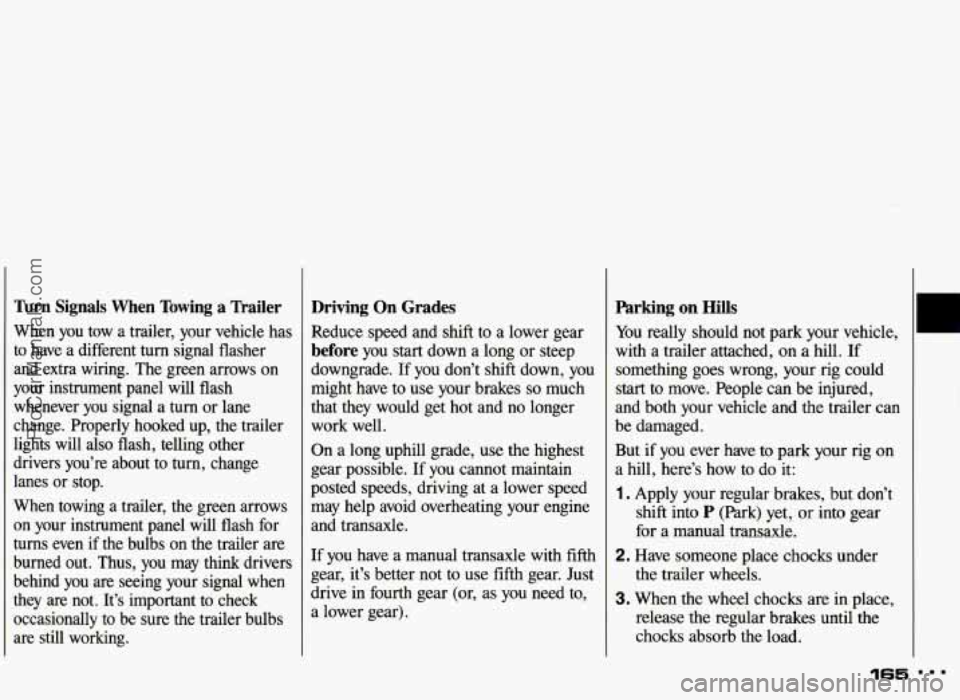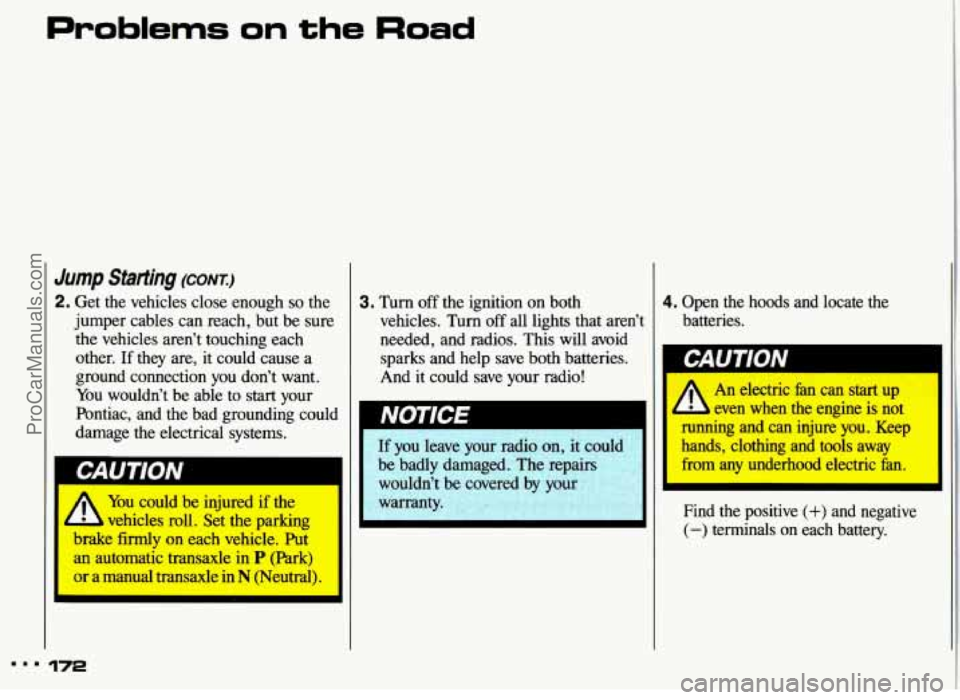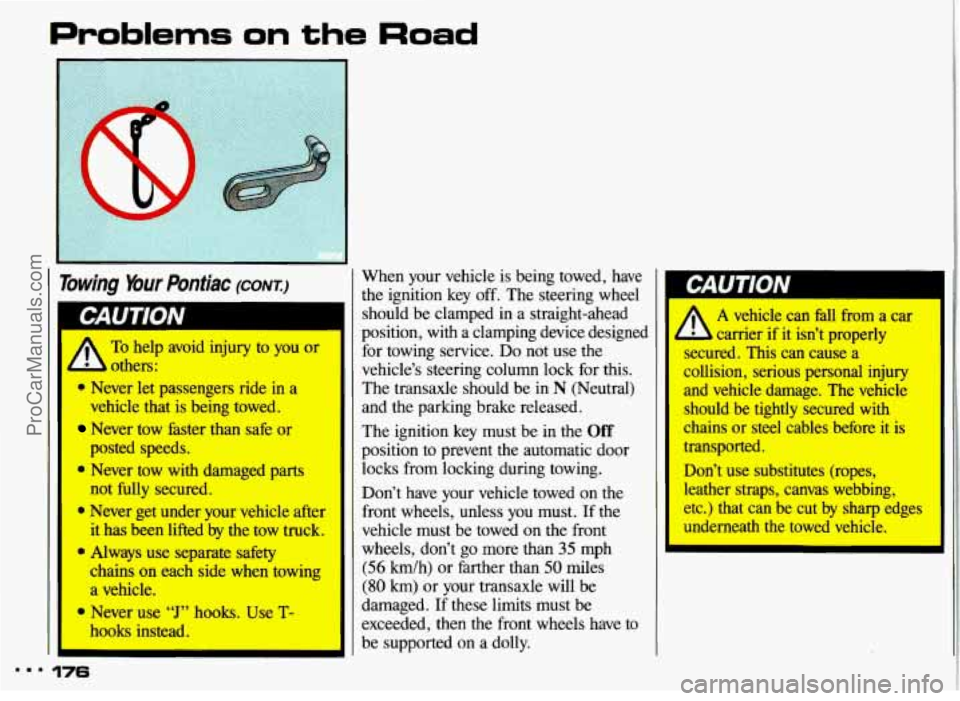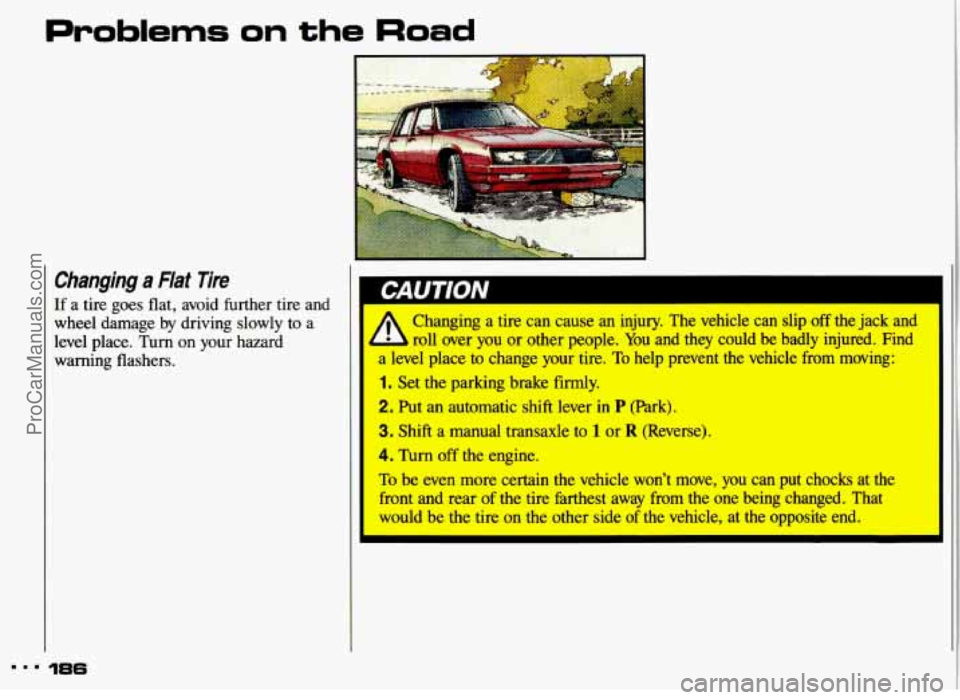1993 PONTIAC GRAND-AM parking brake
[x] Cancel search: parking brakePage 156 of 306

If you’re going uphill on a one-way
uphill,
turn the wheels to the right.
street and you’re parking on the left
If there is no curb when you’re parking
uphill on the left side
of a one-way right.
If there is no curb when you’re parking
side, your wheels should point to the
street, your wheels should
be turned to
the left:
Toque Lock (AUTOMATN: rtunsAxLq
If you are parking on a hill and you
don’t shift your transaxle into
P (Park)
properly, the weight of the vehicle may
put too much force on the parking pawl
in the transaxle. You may find it difficult
to pull the shift lever out
of P (Park).
This is called “torque lock,” To prevent
torque lock, always be sure
to shift into
P (Park) properly before you leave the
driver’s seat. To find out how, see the
Index under Shifting Into P (Park).
When you are ready to drive, move the
shift lever out
of P (Park) before you
release the parking brake.
If torque lock does occur, you may need
to have another vehicle push yours a
little uphill to take some
of the pressure
from the transaxle, so you can pull the
shift lever out of P (Park).
c
155
ProCarManuals.com
Page 166 of 306

Turn Signals When Towing a ’Railer
When you tow a trailer, your vehicle has
to have a different turn signal flasher
and extra wiring. The green arrows on
your instrument panel will flash
whenever you signal a
turn or lane
change. Properly hooked up, the trailer
lights will also flash, telling other drivers you’re about to turn, change
lanes or stop.
When towing a trailer, the green arrows
on your instrument panel will flash for
turns even if the bulbs on the trailer are
burned out. Thus, you may think drivers
behind you are seeing your signal when
they are not. It’s important to check occasionally to be sure the trailer bulbs
are still working.
Driving On Grades
Reduce speed and shift to a lower gear
before you start down a long or steep
downgrade. If you don’t shift down, you
might have to use your brakes
so much
that they would get hot and no longer work well.
On a long uphill grade, use the highest
gear possible. If you cannot maintain
posted speeds, driving at a lower speed
may help avoid overheating your engine
and transaxle.
If you have a manual transaxle with
fifth
gear, it’s better not to use fifth gear. Just
drive in fourth gear (or, as you need to,
a lower gear).
Parking on Hills
You really should not park your vehicle,
with a trailer attached,
on a hill. If
something goes wrong, your rig could
start to move. People can be injured,
and both your vehicle and the trailer can
be damaged.
But if you ever have to park your rig on
a hill, here’s how to do it:
1. Apply your regular brakes, but don’t
shift into
P (Park) yet, or into gear
for a manual transaxle.
2. Have someone place chocks under
the trailer wheels.
3. When the wheel chocks are in place,
release the regular brakes until the chocks absorb the load.
165 DDD
ProCarManuals.com
Page 167 of 306

Your Driving and the Road
Driving with a mailer (CONT.)
4. Reapply the regular brakes. Then
apply your parking brake, and then shift to
P (Park), or R (Reverse) for a
manual transaxle.
5. Release the regular brakes.
When You Are Ready to Leave After
Parking on a
Hill
1. Apply your regular brakes and hold
the pedal down while you:
Start your engine;
Shift into a gear; and
Release the parking brake.
2. Let up on the brake pedal.
3. Drive slowly until the trailer is clear
4. Stop and have someone pick up and
of the chocks.
store the chocks.
Maintenance When Tmiler Towing
Your vehicle will need service more
often when you’re pulling a trailer. See
the Maintenance Schedule for more on
this. Things that are especially important in trailer operation are
automatic transaxle fluid (don’t overfiil),
engine oil, belts, cooling system, and
brake adjustment. Each
of these is
covered
in this manual, and the Ida
will help you find them quickly. If
you’re trailering, it’s a good idea to
review these sections before you
start
your trip.
Check periodically to see that all hitch
nuts and bolts are tight.
m.. 166
ProCarManuals.com
Page 173 of 306

Jump Starting (CONTJ
2. Get the vehicles close enough so the
jumper cables can reach, but be sure
the vehicles aren’t touching each
other.
If they are, it could cause a
ground connection you don’t want.
You wouldn’t be able to
start your
Pontiac, and the bad grounding could
damage the electrical systems.
I; vehicles roll. Set the parking
brake
firmly on each vehicle. Put
an automatic transaxle in
P (Park)
or a manual transaxle in
N (Neutral). I I
3. Turn off the ignition on both
vehicles. Turn
off all lights that aren’t
needed, and radios.
This will avoid
sparks and help save both batteries.
And it could save your radio!
. 8. r ~
I If you leave your radio on, it could
4. Open the hoods and locate the batteries.
An electric fan can start up
e engine is not
running and can injure you. Keep
hands, clothing and tools away
from any underhood electric fan.
Find the positive (+) and negative
(-) terminals on each battery,
I.. 172
ProCarManuals.com
Page 177 of 306

Problems on the Road
Towing Your Pontiac (CONT.:)
A others:
To help avoid injury to you or
0 Never let passengers ride in a
vehicle that is being towed.
Never tow faster than safe or
0 Never tow with damaged parts I
posted speeds.
0 Always use separate safety
chains on each side when towing
a vehicle.
hooks instead.
9 Never use “J” hooks. Use T-
... 176
When your vehicle is being towed, have
the ignition key off. The steering wheel
should be clamped
in a straight-ahead
position, with a clamping device designed for towing service.
Do not use the
vehicle’s steering column lock for this.
The transaxle should be
in N (Neutral)
and the parking brake released.
The ignition key must be in the
Off
position to prevent the automatic door
locks from locking during towing.
--
not fully secured. Don’t have your vehicle towed on the
Never get under your vehicle after front wheels, unless you must. If the
it has been lifted by the tow truck. vehicle must be towed on the front
wheels, don’t go more than
35 mph
(56 km/h) or farther than 50 miles
(80 km) or your transaxle will be
damaged. If these limits must be
exceeded, then the front wheels have to
be supported
on a dolly.
‘I
I‘
W
I A vehicle can fall from a car
b carrier if it isn’t properly
secured. This can cause a
collision, serious personal injury
I and vehicle damage. The vehicle
should be tightly secured with
chains or steel cables before it is
transported.
Don’t use substitutes (ropes, leather straps, canvas webbing,
etc.) that can be cut by sharp edges
underneath the towed vehicle.
ProCarManuals.com
Page 187 of 306

Problems on the Road
Changing a Flat lire
If a tire goes flat, avoid further tire and
wheel damage by driving slowly to a
level place. Turn
on your hazard
warning flashers.
186
IUII
Changing a tire can cause an injury. The vehicle can slip off the jack and
roll over you or other people. You and they could be badly injured. Find I
a level place to change your tire. To help prevent the vehicle from moving:
1. Set the parking brake firmly.
2. Put an automatic shift lever in P Wk). I
3. Shift a manual transaxle to 1 or R (Reverse).
4. Turn off the engine.
To be even more certain the vehicle won't move, you can put chocks at the
front and fear of the tire farthest away from the one being changed. That
would be the tire on the other side of the vehicle, at the opposite end.
ProCarManuals.com
Page 218 of 306

the transaxle fluid level if you have been
driving:
When outside temperatures are abve
At high speed for quite a while.
In heavy traffic-especially in hot
While pulling a trailer.
Ta get the right reading, the fluid should
be at normal operating temperature,
which
is 180°F to 200°F (82°C to
93°C).
Get the vehicle warmed up by driving
about 15 miles (24 km) when outside
temperatures are above 50°F (10°C). If
it’s colder
than 50°F (lO°C), you may
have to drive longer.
90°F (32°C).
weather.
0 Park your vehicle an a level place.
Place the shift lever in F (Park) with
With your foot on the brake pedal,
the parking brake applied.
move the shift lever through each gear
range,
pausing for about three seconds
in each range. Then, position the shift
lever
in P (Park).
five minutes.
Let the engine run at idle for three to
Then, Without Shutting OMF the
Engine, Follow These Steps:
1. Pull out the dipstick and wipe it with
a clean rag or paper towel.
2. Push it back in all the way, wait three
seconds and then pull
it back out
again.
3. Check both sides of the dipstick, and
read the luwer level. The fluid level
must be
in the crass-hatched area.
4. If the fluid level is where it should
be, push the dipstick back in all the
way.
ProCarManuals.com
Page 269 of 306
![PONTIAC GRAND-AM 1993 Owners Manual Maintenance Schedule
Section A: Scheduled Maintenance Services [cant.]
Explanation of Scheduled Maintenance Services
Below are explanations of the services listed in Schedule I
and Sched PONTIAC GRAND-AM 1993 Owners Manual Maintenance Schedule
Section A: Scheduled Maintenance Services [cant.]
Explanation of Scheduled Maintenance Services
Below are explanations of the services listed in Schedule I
and Sched](/manual-img/50/58387/w960_58387-268.png)
Maintenance Schedule
Section A: Scheduled Maintenance Services [cant.]
Explanation of Scheduled Maintenance Services
Below are explanations of the services listed in Schedule I
and Schedule II.
The proper fluids and lubricants to use are listed in
Section D. Make sure whoever services your vehicle uses
ITEM
NO. SERVICE
1 Engine Oil and Filter Change-Always use SG
Energy Conserving 11 oils of proper viscosity.
The “SG” designation may be shown alone or
in
combination with others, such as “SG/CC,”
“SG/CD” or
“SF, SG, CC,” etc. If you have the
2.3L Quad OHC or a Quad
4 engine, the preferred
viscosity for your vehicle’s engine is
SAE 5W-30.
However, you can use
SAE 1OW-30 if it’s going to
be
0°F (-18°C) or above. If you have the 3300 V6
engine, the preferred viscosity for your vehicle’s
engine is
SAE 1OW-30. However, you can use SAE
5W-30 if it’s going to be 60°F (16°C) or below. these. All parts should be replaced and all necessary repairs
done before you or anyone else drives the vehicle.
NOTE: To determine your engine’s displacement and code,
see the
Index under Engine Identijication.
ITEM
NO.
2
3
4
SERVICE
Chassis Lubrication-Lubricate the transaxle shift
linkage, parking brake cable guides, underbody
contact points and linkage. Lubricate the front and
rear suspension, steering linkage and fuel filler
door and striker plunger.
Throttle
Body Mounting Bolt Torque (3300 V6
Code N engine)*-Check the torque of the
mounting bolts and/or nuts.
Tire and Wheel Rotation and Inspection-For
proper wear and maximum tire life, rotate your
tires following the instructions in this manual. See
the
Index under llres, Inspection & Rotation.
Check the tires for uneven wear or damage. If you
see irregular or premature wear, check the wheel
alignment. Check for damaged wheels
also.
* An Emission Control Service.
i? The US. Environmental Protection Agency has determined that the failure to pe@orm this maintenance item will not nullifL the emission warranty or
limit recall liability prior to the completion
of vehicle useful life. General Motors, however, urges that all recommended maintenance sem’ces be
peflormed at the indicated intervals and the maintenance be recorded in Section E: Maintenance Record.
268
ProCarManuals.com